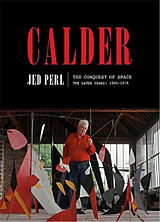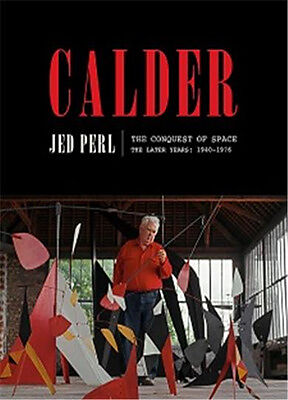Calder : The Conquest of Space : The Later Years 1940-1976
Einband:
Broschiert
EAN:
9780451494115
Untertitel:
The Later Years: 1940-1976
Genre:
Briefe & Biografien
Autor:
Jed Perl
Herausgeber:
Knopf Doubleday Publishing Group
Anzahl Seiten:
688
Erscheinungsdatum:
14.04.2020
ISBN:
0451494113
The concluding volume to the first biography of one of the most important, influential, and beloved twentieth-century sculptors, and one of the greatest artists in the cultural history of America--is a vividly written, illuminating account of his triumphant later years. The second and final volume of this magnificent biography begins during World War II, when Calder--known to all as Sandy--and his wife, Louisa, opened their home to a stream of artists and writers in exile from Europe. In the postwar decades, they divided their time between the United States and France, as Calder made his first monumental public sculptures and received blockbuster commissions that included Expo '67 in Montreal and the 1968 Olympics in Mexico City. Jed Perl makes clear how Calder's radical sculptural imagination shaped the minimalist and kinetic art movements that emerged in the 1960s. And we see, as well, that through everything--their ever-expanding friendships with artists and writers of all stripes; working to end the war in Vietnam; hosting riotous dance parties at their Connecticut home; seeing the "mobile," Calder's essential artistic invention, find its way into Webster's dictionary--Calder and Louisa remained the risk-taking, singularly bohemian couple they had been since first meeting at the end of the Roaring Twenties. The biography ends with Calder's death in 1976 at the age of seventy-eight--only weeks after an encyclopedic retrospective of his work opened at the Whitney Museum in New York--but leaves us with a new, clearer understanding of his legacy, both as an artist and a man.
"The noted art critic concludes his stately, authoritative biography with this look at the sculptor’s career triumphs and legacy."—The New York Times
“It takes a big-hearted, ambitious biographer to take on the life of a big-hearted, ambitious artist. Alexander Calder has found a perfect match in Jed Perl.”—The Washington Post
“A passionate, erudite, and scrupulously researched reckoning with one of the 20th century’s most exciting artists.”—The Atlantic
“A well-researched and engaging narrative rich in anecdotes . . . By the end of Mr. Perl’s second volume, we are left in no doubt as to the depth and durability of Calder’s career.”—The Wall Street Journal
"Perl’s narrative makes Calder come alive . . . Unlike the other major artists of the 20th century, Calder has never had a comprehensive biography that set his life and work in context. Thanks to Jed Perl’s magisterial work, now he does."—The Christian Science Monitor
“The monumental conclusion to a two-part biography of Alexander Calder . . . In this masterfully researched work, Perl has constructed an impressive monument that should raise the standards for future art biographies . . . Erudite and accessible . . . Exquisite . . . A towering achievement.”—Kirkus Reviews (starred)
“Perl completes his magisterial biography of sculptor Alexander Calder with this lavishly illustrated volume . . . Calder admirers will delight in this exhaustively researched and illuminating retrospective.”—Publishers Weekly (starred)
Autorentext
Jed Perl
Leseprobe
PROLOGUE
GRAND RAPIDS 1969
I
On June 14, 1969, a bright, cloudless Saturday, Alexander Calder and his wife, Louisa, were in Grand Rapids, Michigan, for the dedication of La Grande vitesse, the enormous steel sculpture he had made for the plaza in front of the recently completed City Hall. Calder, who was seventy that June, had been dreaming about a new kind of public monument since soon after he became an abstract artist early in the 1930s. But it was only in the 1960s that those dreams were becoming realities. The times were nothing if not dramatic, and the unprecedented arrival of a colossal abstract sculpture in the heart of a conservative midwestern city was just one more small twist in a decade full of surprises. The summer of 1967 had become the Summer of Love; the anti- war movement had brought down a president; a month after the dedication of La Grande vitesse a man walked on the moon. Although much too old to be part of the decade’s youthquake, the Calders embraced the idealistic spirit of the 1960s. The immense abstract monuments that Calder was beginning to create were as bold, as wild, as brilliant, as strange, as idiosyncratic, and as unprecedented as the times in which they were produced. A good friend, thinking of Calder’s indefatigable experimentation, wrote that some of his new work suggested an “adventurous and carefree student-like march.”
On the day of the dedication of La Grande vitesse, some two thousand people gathered in downtown Grand Rapids to welcome the artist and his art. The mood was celebratory, with children cavorting at the foot of the monument. The local symphony played a work for woodwind and percussion composed for the occasion by Aaron Copland. Copland and Calder knew each other a little and shared the steadiness of purpose that American modernists needed to forge an art with international ramifications. La Grande vitesse, with its arching and curving forms and coat of bright red paint, was a colossus unlike any the United States had ever seen. It was a new kind of urban landmark. The steel plates—they weighed a total of forty-two tons and were locked together with hundreds of bolts—had a muscular energy. Some midwestern skeptics might have dismissed La Grande vitesse, erected as part of the Vandenberg Center in downtown Grand Rapids, as a monumental joke. But if Calder’s sculpture hadn’t been something of an enigma, it wouldn’t have been so exhilarating. By embracing La Grande vitesse, the citizens of Grand Rapids were also embracing the experimental spirit of the avant-garde. Charles Olson, a prophetic voice in modern American poetry, had once spoken of his country as “a complex of occasions” that created a geometry of a “spatial nature.” La Grande vitesse was a revolutionary geometry, and to move around it was to encounter a “complex of occasions”— occasions that the men and women of Grand Rapids were only beginning to grasp. What Calder had created was an imaginative exaltation.
Calder had a fine time in Grand Rapids, although he afterward confessed to an old friend, the architect Josep Lluís Sert, that he had been a little reluctant about traveling to Michigan for the dedication. He had no ties to Grand Rapids, to Michigan, or for that matter to the Midwest. Arriving in this city on the Grand River some thirty miles east of Lake Michigan, he almost immediately asked to be shown the river; he wanted to get the lay of the land. On being handed the keys to the city during the dedication, this serious man who was perfectly willing to adopt the role of the joker if it might lighten the mood at an official event, shot back, “But will it open cans?” Calder’s mother, Nanette Lederer, had been born in Milwaukee, just across Lake Michigan from Grand Rapids, but while still a young woman she had left the Midwest to become an artist in Philadelphia. Calder certainly had some sense of the part that Grand Rapids had already played in the history of American design; since the late nineteenth century this had been America’s Furniture City. Twenty years earlier, Calder had fielded an inquiry from Baker Furniture, one of the big outfits in town, about making a mobile for their art gallery. Nothing came of it—and Calder ended up writing to his …

Leider konnten wir für diesen Artikel keine Preise ermitteln ...
billigbuch.ch sucht jetzt für Sie die besten Angebote ...
Die aktuellen Verkaufspreise von 6 Onlineshops werden in Realtime abgefragt.
Sie können das gewünschte Produkt anschliessend direkt beim Anbieter Ihrer Wahl bestellen.
Loading...
Die aktuellen Verkaufspreise von 6 Onlineshops werden in Realtime abgefragt.
Sie können das gewünschte Produkt anschliessend direkt beim Anbieter Ihrer Wahl bestellen.
| # | Onlineshop | Preis CHF | Versand CHF | Total CHF | ||
|---|---|---|---|---|---|---|
| 1 | Seller | 0.00 | 0.00 | 0.00 |
